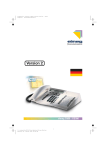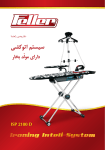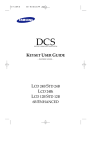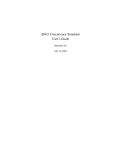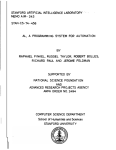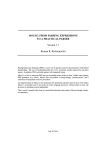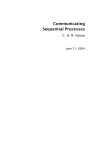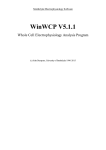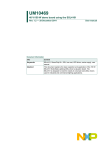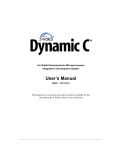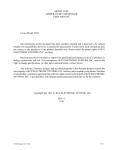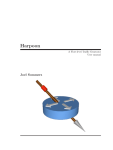Download Pascal-FC Version 5 User Guide for PC Compatibles PC
Transcript
Pascal-FC
Version 5
User Guide for PC Compatibles
PC-PP
G.L. Davies
University of Bradford, UK
____________________________________
G.L. Davies 1992. Permission to copy without fee all or part of this document is granted provided that the copies are not
made or distributed for direct commercial advantage.
Pascal-FC for PC
1. INSTALLATION UNDER DOS
It is recommended that Pascal-FC be used on a system with a hard disc, but use of a
floppy-disc system is feasible. In either case, the first task is to copy the distribution disc
to a working disc, and store the distribution disc in a safe place.
1.1. Installation on a hard disc system
A SETUP program is distributed with the system. It will set up a directory structure for
the Pascal-FC system. The procedure is as follows:
1.
Decide on the name and drive you want the Pascal-FC system to be loaded into. By
default, this is C:\PASFC, but the SETUP program invites you to enter an
alternative name if this is not suitable.
2.
Run the SETUP program.
3.
Edit your AUTOEXEC.BAT file to include \PASFC\BIN (substituting your
alternative name for "PASFC" if you did not select the default) in the PATH
variable.
If you successfully complete these steps, you can run the Pascal-FC system as described
in Chapter 3.
1.1.1. The SETUP program
This program copies all the files you need to build a working system, together with a
selection of example programs. The test programs are in a series of subdirectories of the
directory EX, which is itself a sub-directory of PASFC. Note that you can over-ride the
default name for the root of this structure (PASFC), but you have no control over the
names of the sub-directories.
To run the SETUP program, enter:
A:SETUP
The program invites you to choose an alternative name for the root directory. If the
default name is suitable, press ENTER. In this case, if a directory C:\PASFC already
exists, then you will be asked whether you wish to continue. Entering "y" or "Y" will
cause the existing C:\PASFC directory to be used. Any files or directories with the same
names as those on the distribution kit will be over-written, but others will be unaffected.
Pressing any other key causes the SETUP program to halt without copying any files. A
file A:\READ_ME will be found on the distribution disc: this gives further information
about the directory structure that will be set up.
FC-UG-PC-P/P-1/1.2
-2-
Pascal-FC for PC
2.
OPTIONAL
FEATURES
AND
IMPLEMENTATION-DEPENDENT
2.1. Data types supported
2.1.1. The type integer
Integers have 16 bits of precision. The value of maxint is 32767, and the smallest
integer that can be represented is -maxint (not -maxint-1).
2.1.2. The type char
The ASCII character set is used. Valid parameters to the chr function range from 0 to
127.
2.1.3. The type real
The standard type real is supported by this implementation. Real numbers are
represented with approximately 7 significant digits. The approximate range of real
numbers that can be represented is from -9.999999E37 to +9.999999E37. Any real
number with an exponent more negative than -37 is considered zero.
2.1.4. The type bitset
These are sets of 0 .. 7. The write and writeln procedures use binary
notation for values of this type, with the most significant bit on the left. The int
function treats a bitset as an 8-bit unsigned integer, and the bits function performs the
inverse operation.
2.2. Based literals
The values for the base in a based literal are restricted to "2", "8" and "16". The compiler
will flag an error if any other value is used.
2.3. Based output
The values for the base in a write or writeln call are restricted to "8" and "16".
Any other value will cause hexadecimal format to be used (no error will be flagged).
Based output is not applicable to the type real, nor can based output be used in
conjunction with field-width specifications.
2.4. Based input
Integers may be input in binary, octal, hexadecimal or decimal forms in response to
read(ln). Decimal is the default, and the format for the other bases is exactly the
same as that required in a Pascal-FC source program. The format must not be specified
in the source program: input is interpreted appropriately at run time.
FC-UG-PC-P/P-2/1.3
-3-
Pascal-FC for PC
2.5. Processes and Process Scheduling
2.5.1. Choice from among executable processes
This implementation supports two different schedulers, which we call the standard and
the unfair. In either case the standard procedure, priority, has the same effect as the
null statement.
2.5.1.1. The standard scheduler
The standard scheduler is pre-emptive, which means that a process can be forced to
relinquish the processor even though it is still executable. The scheduler selects a
process to run by generating a random number. In addition, having determined which
process to run, it generates a random number which determines how many instructions
the process will be allowed to execute before it is next forced out of the processor. In
practice, this number is small, so that process switches will occur frequently and no one
process receives preferential treatment. This scheduler is particularly useful for revealing
errors due to uncontrolled multiple update.
2.5.1.2. The unfair scheduler
The unfair scheduler uses a different rule to select a ready process for running. Rather
than generating a random number, it always chooses the lowest-numbered executable
process. Processes are numbered in the order in which they were activated in the
concurrent statement. The unfair scheduler is not pre-emptive: once a process is
running, it will continue to do so until either it blocks or runs to completion.
2.5.2. Maximum number of processes
There is no specific limitation on the number of processes that can be declared in a
program, but no more than 20 may be activated in the concurrent statement. An attempt
to exceed this number will cause the run-time system to abort the program.
2.6. Semaphores
In the event that there are several processes suspended on a semaphore when a signal
is carried out, a random choice is made to determine which of them to unsuspend. This is
not affected by the scheduler in use.
2.7. Monitors
As there is no notion of process priority in this implementation, all queues associated
with monitors (including those on condition variables) are strictly FIFO. This is not
affected by the scheduler in use.
2.8. Resources
The implementation of resources has the following characteristics:
1.
Mutual exclusion at a resource boundary is implemented by a FIFO queue.
FC-UG-PC-P/P-2/1.3
-4-
Pascal-FC for PC
2.
Barriers on guarded procedures are FIFO queues.
3.
If there are several processes suspended on true barriers which could inherit
mutual exclusion of the resource, a random choice is made to determine which is
successful.
The above points apply regardless of which scheduler is used.
2.9. Ada-style rendezvous
Process entries have FIFO queues, which are not affected by the scheduler in use.
2.10. Selective Waiting
When there are several channel or accept alternatives which have open guards and
pending calls, a random choice is made among them, except where the pri select is
concerned. In the latter case, textual order determines the choice. The scheduler has no
influence on the choice of rendezvous.
2.11. Timing Facilities
The system clock unit is one second. The clock function returns the time in seconds
since the beginning of execution of the program.
The timing facilities in this implementation are designed on the assumption that
only comparatively short program runs will be required. The system clock will become
negative if the program runs for more than about 9 hours, and timings will become
unreliable as this time approaches.
The timing facilities provide only approximate timings: a process which executes
the sleep procedure, or a select with a timeout alternative may be made
runnable up to one second early.
2.12. Low-level Facilities
This implementation does not support mapping indicators in variable or entry
declarations or offset indicators in record field declarations. There is in consequence no
facility to manipulate hardware device registers or to handle interrupts. The type
bitset is supported, and has been described earlier.
2.13. Restrictions imposed by compiler Internal Tables
Table 2.1 lists the relevant restrictions. Exceeding any of these limits, except the number
of significant characters in an identifier, will result in a fatal error. In the case of an
identifier, characters in excess of the limit are read but discarded.
FC-UG-PC-P/P-2/1.3
-5-
Pascal-FC for PC
_______________________________________________________________________
________________________________________________________
Number of significant characters in an identifier
10 Maximum source line length (characters)
_ _______________________________________________________
121 ________________________________________________________
150 Size of identifier table (entries)
Size of block table (entries)
30 _ _______________________________________________________
Size of string table (characters)
________________________________________________________
1500 ________________________________________________________
Size of array table (entries)
20 Maximum depth of nesting of blocks
7 _ _______________________________________________________
________________________________________________________
Maximum length of generated code (P-code instructions) 2000 Size of channel table (entires)
20 _ _______________________________________________________
Maximum number of alternatives in a SELECT
20 ________________________________________________________
________________________________________________________
Maximum exported procedures in a monitor or resource 10 Size of real literal table (entires)
50 _ _______________________________________________________
________________________________________________________
Size of enumeration type table (entires)
20 Maximum number of alternatives in a CASE
20 _ _______________________________________________________
Maximum number of monitors or resources in a program 10 ________________________________________________________
Table 2.1: Compiler Internal Table Constraints
FC-UG-PC-P/P-2/1.3
-6-
Pascal-FC for PC
3. COMPILING AND RUNNING A PROGRAM
3.1. Invoking the Compiler under MS-DOS
The Pascal-FC system consists of separate compiler and interpreter programs. Figure 3.1
shows the system components and the files that they produce or use.
There are two ways of running a Pascal-FC program using these components:
1.
by use of the pfc command, which compiles and runs the source program by
invoking the two components in turn;
2.
by running the compiler and interpreter separately.
The first of these methods is only available when the compiler and interpreter are on the
same disc It involves less typing for the user, but the second method has the advantage
source
code
FC
compiler
listfile
objfile
FC
interpreter
. . . . . . . . . . . pmdfile
Figure 3.1: Files and Pascal-FC System Components
FC-UG-PC-P/P-2/1.3
-7-
Pascal-FC for PC
that pre-compiled programs can be run without re-compilation. This is particularly
useful if you want to investigate the influence of the scheduling policy on your program,
as the choice of scheduler is an option to the interpreter.
3.1.1. The pfc command
If you have the hard-disc or 3.5 inch floppy disc system, the pfc command can be used
to compile and run the source program. The command has the form:
pfc [-uf] <sourcefile_name>
No file name conventions are enforced by the compiler, but it is recommended that you
use a .pfc extension. The optional -uf flag causes the unfair scheduler to be used in
running the program: the default is the standard scheduler.
3.1.2. Running the compiler and interpreter separately
To invoke the compiler, a command of the following form is used:
pfccomp <sourcefile_name> <listfile_name> <objfile_name>
Unless you want to save listings and compiler output from different programs, it is best to
use listfile and objfile respectively for the last two arguments. However, the
objfile produced by the compiler is large, so that it is not desirable to store programs
in this form for long periods.
The code generated by the compiler is used as input to the Pascal-FC interpreter.
Two versions of the interpreter are supplied: they are identical except that one of them
incorporates the standard scheduler, and the other the unfair scheduler.
If there are no compile-time errors, the program may be run by typing the
command:
pint <objfile_name> <pmdfile_name>
if the standard scheduler is required, or:
ufpint <objfile_name> <pmdfile_name>
for the unfair scheduler. The pmdfile is used by the system to collect post-mortem
information in the event of a run-time error (see Section 3.3).
The Pascal-FC program may be re-run any number of times without the need to
restart the interpreter. The following message will be displayed:
Type r and RETURN to rerun
Typing "r" or "R" will cause the program to run again; any other character will terminate
the interpreter.
Using the standard scheduler, re-running a program in this way will in general
produce a different interleaving of processes. Note that there may be some indeterminacy
even when using the unfair scheduler, because some scheduling decisions are still
determined randomly (for example, when a signal is carried out on a semaphore on
which several processes are blocked),
FC-UG-PC-P/P-3/1.3
-8-
Pascal-FC for PC
3.2. Input and output redirection
Input and output redirection are not available when using the pfc command. Output
produced by the source program is normally sent to the screen. Normal MS-DOS output
redirection can be used when invoking the interpreter if a permanent copy of program
output is required. However, redirection is not entirely satisfactory, because any prompts
for input from the source program will also be redirected to the named file. So, indeed,
will the invitation to "Type r to rerun" when the program has been executed.
Input redirection is also feasible, but the response to the invitation to re-run must be
included with the input data if more than one run is required. In preparing the data file,
the user should bear in mind that the interpreter code which manages the re-run facility
has the form:
repeat
runprog;
writeln;
writeln(’Type r and RETURN to rerun’);
if eoln then readln;
if eof then
ch := ’x’
else
readln(ch);
writeln;
until not (ch in [’r’,’R’])
Hence, the Pascal-FC source program may or may not need an explicit readln to
consume all the data prior to the re-run response. If the file is intended to contain only
sufficient data for one run, then the response to the prompt need not be included, because
the interpreter will detect the end-of-file condition and exit normally.
3.3. The run-time post-mortem dump
Pascal-FC provides a post-mortem dump when a program generates a run-time error.
The dump is sent to a file with the name specified by pmdfile_name when the
interpreter was called. No file with this name is produced if the program terminates
normally.
The post-mortem dump is intended to be self-explanatory, and it will be introduced
here by means of examples, with a small number of supporting comments.
3.3.1. Example: accidental omission of a terminate alternative
The following is an attempt at a buffered solution to the producer-consumer problem
using channels. However, there is no terminate alternative in the buffer process.
FC-UG-PC-P/P-3/1.3
-9-
Pascal-FC for PC
program pcon6a;
(* buffered producer-consumer with channel rendezvous *)
var
inp, out: channel of char;
process buffer;
const
buffmax = 4;
var
store: array[0..buffmax] of char;
nextin, nextout, count: integer;
begin
nextin := 0;
nextout := 0;
count := 0;
repeat
select
when count <> 0 =>
out ! store[nextout];
count := count - 1;
nextout := (nextout + 1) mod (buffmax + 1);
or
when count < buffmax =>
inp ? store[nextin];
count := count + 1;
nextin := (nextin + 1) mod (buffmax + 1 );
end (* select *)
forever
end; (* buffer *)
FC-UG-PC-P/P-3/1.3
- 10 -
Pascal-FC for PC
process producer;
var
local: char;
begin
for local := ’a’ to ’z’ do
inp ! local
end; (* producer *)
process consumer;
var
local: char;
begin
repeat
out ? local;
write(local);
until local = ’z’;
writeln
end; (* consumer *)
begin
cobegin
producer;
consumer;
buffer
coend
end.
When the program was run, the following appeared on the screen:
FC-UG-PC-P/P-3/1.3
- 11 -
Pascal-FC for PC
- Pascal-FC for IBM PC Compatibles - Compiler Version 5.1 G L Davies
&
A Burns, University of Bradford
Compiling pcon6a
...
Compilation complete
- Interpreter Version 5.1 Program pcon6a
... execution begins ...
abcdefghijklmnopqrstuvwxyz
Abnormal halt in process buffer with pc = 68
Reason:
deadlock
See pmdfile for post-mortem report
Type r and RETURN to rerun
The contents of pmdfile were as follows:
Pascal-FC post-mortem report on pcon6a
- Interpreter Version 5.1 Abnormal halt in process buffer with pc = 68
Reason:
deadlock
---------Main program
Status:
awaiting process termination
---------Process producer
Status:
terminated
FC-UG-PC-P/P-3/1.3
- 12 -
Pascal-FC for PC
---------Process consumer
Status:
terminated
---------Process buffer
Status:
pc = 68
active
Process suspended on:
inp (channel)
==========
Global variables
(None)
Two points should be borne in mind when interpreting the post-mortem dump:
(1) The approximate position in the Pascal-FC source code where a process has been
aborted can be found by using the program counter values printed in the associated
listfile. The value of pc given in the post-mortem dump is the next
instruction which would have been executed.
(2) Only non-structured variables of types integer, real, char, boolean
and semaphore will be listed in the global variables section of the report.
3.3.2. Example: rendezvous that can never occur
Finally, here is a second example, together with the post-mortem dump produced.
program pmdtest5;
const
nchans = 5;
var
chanarray: array[1..nchans] of channel of synchronous;
FC-UG-PC-P/P-3/1.3
- 13 -
Pascal-FC for PC
process p;
var
loop: integer;
begin
select
for loop := 1 to nchans replicate
chanarray[loop] ? any
end
end;
begin
cobegin
p
coend
end.
Pascal-FC post-mortem report on pmdtest5
- Interpreter Version 5.1 Abnormal halt in process p with pc = 21
Reason:
deadlock
---------Main program
Status:
awaiting process termination
FC-UG-PC-P/P-3/1.3
- 14 -
Pascal-FC for PC
---------Process p
Status:
pc = 21
active
Process suspended on:
chanarray[1]
chanarray[2]
chanarray[3]
chanarray[4]
chanarray[5]
(channel)
(channel)
(channel)
(channel)
(channel)
==========
Global variables
(None)
FC-UG-PC-P/P-3/1.3
- 15 -
Pascal-FC for PC
APPENDIX A - THE COMPILER LISTING FILE
1. Form of the listing file
The contents of the listing file fall into the following sections:
(1) the source code listing itself;
(2) the symbol table generated from the program;
(3) the generated code.
Only the first of these sections will be of any interest to the majority of users. Hence, the
symbol table and generated code have been omitted from the example in the following
section.
2. An example
- Pascal-FC for IBM PC Compatibles - Compiler Version 5.1 G L Davies
&
A Burns, University of Bradford
Compiler listing for file gardens1.pfc
1
2
3
4
5
6
7
8
9
10
11
12
13
14
15
16
17
18
0 program gardens1;
0
0 (* first attempt to solve the
0
ornamental gardens problem *)
0
0 var
0
count: integer;
0
0
0
0
0
0
0
4
7
10
10
FC-UG-PC-P/P-A/1.3
process turnstile1;
var
loop: integer;
begin
for loop := 1 to 20 do
count := count + 1
end; (* turnstile1 *)
- 16 -
Pascal-FC for PC
19
20
21
22
23
24
25
26
27
28
29
30
10
11
11
11
11
11
15
18
21
21
21
21
process turnstile2;
31
32
33
34
35
36
37
38
21 begin
22
count := 0;
25
cobegin
26
turnstile1;
30
turnstile2
30
coend;
35
writeln(’Total admitted: ’,count)
39 end.
var
loop: integer;
begin
for loop := 1 to 20 do
count := count + 1
end; (* turnstile2 *)
2.1. Comments on the listing
It will be seen that the compiler has pre-pended two integers to each line of the original
source code. The first is clearly a line number. The second is the instruction counter for
the generated code, and it represents the count as it was when the compiler began to
process the line concerned. This information is useful because the interpreters quote the
instruction counter when they encounter a run-time error, so that the approximate
location of the problem can be determined.
FC-UG-PC-P/P-A/1.3
- 17 -
Pascal-FC for PC
APPENDIX B - COMPILE-TIME ERRORS
1. Types of error
Error-messages generated by the Pascal-FC system fall into two categories:
(1) compile-time errors;
(2) run-time errors.
Run-time errors are considered in Appendix C.
The compile-time errors may be further divided into the following sub-categories:
(a) fatal errors, usually due to compiler internal table overflow;
(b) violations of the syntax of Pascal-FC;
(c) use of optional Pascal-FC facilities not supported by this implementation.
2. Fatal errors
Most of these errors are caused by overflow in one of the compiler’s internal tables. The
two exceptions are:
•
program incomplete. This message is generated when the compiler unexpectedly
reaches the end of the program source file.
•
input line too long. An internal line buffer limits the length of lines in the source
program. The limit was specified in Table 2.1.
The remaining fatal errors, which are all due to table overflow, all produce messages
which name the table involved. The following notes provide additional information to
assist in the interpretation of these messages.
1
identifier. The symbol table has overflowed. This table is used to record all
identifiers used in a program.
2
blocks. Every subprogram, monitor, resource, record type and entry declared in a
program is recorded in the block table.
3
strings. All string literals used in the source program are recorded in this table.
4
arrays. Each new array type declared is recorded in this table. This includes
"anonymous" array types introduced in var declarations.
5
levels. The degree of nesting of blocks or of record types is excessive.
6
code. The source program has generated too much code.
7
channels. This is analogous to the case for arrays. Each new channel type declared
in the program is recorded in the channels table.
8
select. There are too many alternatives in a select statement. Note that a
replicate alternative counts as a single alternative.
9
monprocs. There are too many exported procedures in a monitor or resource.
10
reals. Every unique real literal used in a program is entered into this table.
FC-UG-PC-P/P-B/1.4
- 18 -
Pascal-FC for PC
11
interrupts. Every semaphore, channel or entry declared with a mapping
indicator is entered into this table.
12. enum type. Each new enumeration type declared requires an entry in this table.
This includes "anonymous" types introduced in var declarations.
13
case. There are too many alternatives in a case statement.
14
monitors. Too many monitors or resources have been declared in the program.
The values of the constants governing the sizes of the above tables will be found in Table
2.1.
3. Non-fatal Errors
3.1. List of messages
Some of the error messages may require the brief explanations given below. Others are
self-explanatory, and have been simply listed for completeness.
E0 Undeclared identifier. A reference has been made to an identifier which has not
been declared, or is not in scope.
E1 Identifier duplicated. An attempt has been made to declare an identifier which has
already been declared in the current scope.
E2 Identifier expected. This error may be generated in numerous circumstances, such
as in constant, type or variable declarations and in the formal parameter lists of
subprograms.
E3 Type error. Generated in many circumstances where operands have invalid types.
E4
"(" expected.
E5 ")" expected.
E6 "[" expected.
E7 "]" expected.
E8 ":" expected.
E9 ";" expected.
E10 "." expected.
E11 "=" expected.
E12 ":=" expected.
E13 "program" expected. This is generated if the first line of the source file does not
begin with "program". (Comments excepted).
E14 "of" expected.
E15 "then" expected.
E16 "until" or "forever" expected.
E17 "do" expected.
FC-UG-PC-P/P-B/1.4
- 19 -
Pascal-FC for PC
E18 "to" expected.
E19 "begin" expected.
E20 "end" expected.
E21 "select" expected.
E22 "export" expected. The first item in a monitor or resource declaration must be an
export list.
E23 "replicate" expected. When using the replicator in the select statement for
rendezvous by channel, the "replicate" has been omitted ("do" may have been
erroneously used instead).
E24 Error in parameter list. A formal parameter list does not begin with an identifier
or with var, or the actual parameters in a subprogram call or entry call do not
match the associated formals.
E25 Must be var parameter. Semaphore, condition and channel objects may be passed
as parameters to subprograms (including processes), but they must be formally
declared as var parameters. If they were permitted to be passed as value
parameters, then any operations carried out within the subprogram would access and
modify only a local copy, which would defeat their purpose for inter-process
communication.
E26 Parameter list does not match previous declaration. In an accept statement,
the formal parameters of the entry do not match exactly those given in the
declaration of that entry.
E27 Illegal character.
E28 Unexpected symbol. This error can be generated in many circumstances when the
next lexical symbol in the source program is not what the compiler expects.
E29 String expected.
E30 Level error. A language feature has been used at a static level which is
inappropriate for that feature. For example, an inter-process communication
primitive has been declared elsewhere than in the declaration part of the main
program (Level 1), or an entry call has been made in the main program statement
part.
E31 Number error. An error has been detected in an integer or real literal. For
example, an integer literal is too large for the implementation.
E32 Assignment not permitted. The variable on the left of an assignment operator is
an inter-process communication type, or is a structured object having such a type as
a component.
E33 exported monitor/resource procedure(s) not declared. One or more identifiers
appeared in the export list of a monitor or resource for which no corresponding
procedure declaration was found. The message will appear following the final end
of the offending monitor or resource.
FC-UG-PC-P/P-B/1.4
- 20 -
Pascal-FC for PC
E34 Must not be var parameter. The control variable of a for statement or
replicate alternative may be a variable declared within the same block, a
variable declared in an enclosing block, or a value parameter of the subprogram
containing the for or replicate. It must not, however, be a variable
parameter of that subprogram.
E35 Malformed entry call. The compiler has interpreted a statement as an entry call,
but its form is incorrect. As well as errors in statements which the programmer
actually intended as entry calls, this message will be generated if an attempt is made
to activate a process anywhere outside the concurrent statement of the main
program.
E36 Not allowed in a process. A language feature has been used that should not appear
in a process declaration (for example, a nested process declaration).
E37 This type must not be mapped. It is illegal to use a mapping indicator with any
condition object, or any structured object which contains a semaphore object or a
channel object.
E38 "Timeout", "terminate" and "else" mutually exclusive. More than one of these
mutually exclusive alternatives has been used in a select statement.
E39 Multiple cobegins.
E40 "Forward" declarations(s) not resolved. The declaration part of a block contains
a forward declaration of a procedure or function for which no full declaration
has been given. This message is signalled at the end of the declaration part
concerned.
E41 "Provides" declaration(s) not resolved. The provides construction has been
used to predeclare the entries (and possibly the parameters) of a process or process
type, but a full declaration of the process or process type has not been given.
E42 Variable expected.
E43 Missing entry or entries declared in "provides". This error can be generated
during the parsing of the full declaration of a process which has been pre-declared in
a provides construction.
E44 Case label duplicated. In a case statement, two or more alternatives have the
same case label.
E45 Processes not allowed in record fields. A process, or array of processes, has been
declared as a field of a record.
E46 Invalid set literal. A bitset literal is a list of integer expressions enclosed in square
brackets. A set literal has been used that contains a value which is not an integer
expression.
E47 Variable is an array, not a process. When an array of processes has been
declared, each component process must be separately activated in the concurrent
statement: "whole array" activation is not permissible. This error will result if
insufficient subscripts are given when attempting to activate a process declared as an
FC-UG-PC-P/P-B/1.4
- 21 -
Pascal-FC for PC
array element.
E48 Error in array subscript declaration. In the declaration of an array, the type and
range of each subscript is indicated by a constructions of the form lower..higher. If
the ordinal value of lower is in fact greater than that of higher, this error is
generated. In addition, there is a limit set on the ordinal value of both of these
values. Exceeding these limits also generates this error.
E49 Constant expected.
E50 No corresponding "provides" declaration. In parsing the full declaration of a
process which was pre-declared using the provides construction, an entry
declaration has been found that was not included in the provides declaration.
E51 Does not match "provides" declaration. This error is associated with declarations
of entries mapped to interrupt sources. Either the entry concerned was mapped in
the provides construction but not in the full declaration (or vice versa) or the
integer identifying the interrupt source is not the same in the two cases.
E52 Illegally nested accept. An accept statement for a particular entry is nested
inside an accept statement for the same entry.
E53 accept not allowed in subprogram. An accept statement is only
allowed in the statement part of a process.
E54 not allowed in a guarded procedure. An attempt has been made to
nest a guarded procedure declaration inside a guarded procedure declaration.
E55 only allowed in a guarded procedure. A requeue statement can
only be placed in the statement part of a guarded procedure.
E56 destination must be guarded procedure. The destination of a
requeue statement must be a guarded procedure in the current or some other
resource.
E57 only allowed in a resource. Guarded procedures may only be declared
in resources (not monitors).
E58 call not allowed within a resource. An ordinary procedure call to a
guarded procedure of a resource is only allowed from outside a resource.
3.2. Listing file diagnostics for these errors
When any of the above errors are detected in a program, the error diagnostics are sent to
the listing file produced by the compiler, and a rough indication of the location of the
errors is also given in the listing of the source code. In general, the position at which the
compiler finally concludes that an error has occurred is what is indicated, and this is
sometimes a little way beyond the actual site of the error (possibly on a subsequent line).
The following example illustrates the form of the error diagnostics. Note, for example,
that error 9 has not been detected immediately. This program has also generated a fatal
error due to a typographical error in the final end.
FC-UG-PC-P/P-B/1.4
- 22 -
Pascal-FC for PC
- Pascal-FC for IBM PC COmpatibles - Compiler Version 5.1 G L Davies
&
A Burns, University of Bradford
Compiler listing for file errorprone.pfc
1
0
***********
2
0
3
0
4
0
***********
5
0
6
0
7
0
***********
8
0
***********
9
0
***********
10
0
***********
11
0
12
0
13
0
***********
14
2
***********
15
5
16
7
***********
17
8
FC-UG-PC-P/P-B/1.4
rogram errorprone;
ˆ13--------const
1 = 1;
ˆ 2-var
x: reel;
ˆ 0
i,@j: integer
ˆ27
ch: char;
ˆ 9
@
ˆ27
begin
ch := 1;
ˆ 3
i := ’1’ + ’2’;
ˆ 3
j := 3
ebd.
ˆ28
- 23 -
Pascal-FC for PC
Error diagnostics
E0 E2 E3 E9 E13 E27 E28 FATAL
undeclared identifier
identifier expected
type error
’;’ expected
’program’ expected
illegal character
unexpected symbol
ERROR - program incomplete
Following some kinds of error, the compiler is unable to return immediately to the
normal processing of input. In these cases, the input is ignored until normal processing
has been resumed. Sections of input ignored in this way are underlined, as in Line 1 of
the above example.
4. Use of unsupported options
Though this implementation does not support mapping indicators and offset indicators,
the compiler will still check the validity of the syntax of such features in the source
program and report on any errors. In addition, a message will be given to warn that these
facilities are not supported, and the program will not be executable.
FC-UG-PC-P/P-B/1.4
- 24 -
Pascal-FC for PC
APPENDIX C - RUN-TIME ERRORS
In all cases, the generation of a run-time error results in the immediate termination of the
program. In most cases, the approximate position where the error occurred is indicated
by a message which indicates the value of the pc (the generated code counter) at the time
the error occurred. This counter points to the next instruction which would have been
executed had no error occurred.
1. Deadlock
The scheduler is unable to find an "executable" process, and at least one of the processes
in the program is "suspended". Chapter 3 of the Pascal-FC Language Reference Manual
discusses deadlock.
2. Channel error
Two or more receivers (or two or more senders) are attempting to rendezvous on the
same channel. Channels are for point-to-point communication between one receiver and
one sender.
3. Closed guards
In the execution of a select statement, all guards have evaluated to false, and there
is no else part.
4. Attempt to call entry of non-existent/terminated process
A call has been made on an entry of a process that was never activated, or is now
"terminated".
5. Multiple activation of a process
An attempt has been made to activate several instances of a process in the concurrent
statement.
6. Division by zero
This can result from real division or from integer division (using the div and mod
operators).
7. Invalid index
An array subscript is out of range.
8. Illegal character
The argument given to the chr function is outside the range 0..127.
9. Storage overflow
Memory space allocated for the main program or for a process has been exhausted. This
is likely to be caused by large data structures or by deeply nested subprogram calls.
FC-UG-PC-P/P-C/1.2
- 25 -
Pascal-FC for PC
10. Reading past end of file
An attempt has been made to read when there are no more characters in the input file.
This message is relevant when input redirection is being used.
11. More than 20 processes
There is no specific limit on the number of processes that may be declared, but this error
will be generated if an attempt is made in a program to activate more than 20.
12. Statement limit of 200000 reached (possible livelock)
The run-time system will abort the program if the statement limit is reached. A common
cause is livelock, but it may simply be that the program’s execution is too long.
13. Label of ... not found in case
The selector expression in a case statement has a value for which there is no
corresponding alternative.
14. Ordinal value out of range
This can be generated during the execution of the pred and succ operators, or during
the semaphore initial procedure if a negative argument is given.
15. Error in numeric input
When executing a read, an unexpected character has been found, or a numeric value
has been read which is out of range for this implementation, or which uses a number base
other than binary, octal, hexadecimal or decimal.
16. Bitset value out of bounds
There are three circumstances in which this error can occur:
(1) when using the bits type-transfer function, the integer argument supplied cannot
be converted into a bitset without truncation;
(2) when using the in operator, the left operand is not in the range 0..7;
(3) in a set literal, the integer expressions do not all lie in the range 0..7.
17. Arithmetic overflow
This error can result both from integer and real arithmetic operations when the result is
too large (or too negative) to be represented. It is also generated in two cases where an
inappropriate argument has been passed to a standard function:
(1) a negative or zero argument to ln;
(2) a negative argument to sqrt.
FC-UG-PC-P/P-C/1.2
- 26 -
Pascal-FC for PC
18. Attempt to initialise semaphore from process
The main program thread (including procedures and functions called by the main
program, to whatever depth) is the only context in which the initial procedure can
be called.
FC-UG-PC-P/P-C/1.2
- 27 -
Pascal-FC for PC
APPENDIX D - DISCLAIMER AND REPORTING OF FAULTS
Though care has been taken to avoid faults in the Pascal-FC implementations produced at
Bradford, the software is provided without any form of warranty, and the authors cannot
accept any liability arising from its use in any circumstances.
We wish to eliminate any hitherto undetected faults in any of our implementations.
Hence, we invite users who discover faults to report them to: Dr G.L.Davies,
Department of Computing, University of Bradford, Bradford, West Yorkshire, UK, BD7
1DP (email: [email protected]). Please supply the following information:
1.
A listing of the Pascal-FC source program;
2.
any resulting listfile;
3.
any resulting pmdfile;
4.
output results (where appropriate);
5.
a short description of the problem;
6.
an address (preferably electronic mail) where we can contact you.
FC-UG-PC-P-D/1.1
- 28 -
Pascal-FC for PC
CONTENTS
1 INSTALLATION UNDER DOS ......................................................................
1.1 Installation on a hard disc system .............................................................
1.1.1 The SETUP program ............................................................................
2 OPTIONAL AND IMPLEMENTATION-DEPENDENT FEATURES ......
2.1 Data types supported ..................................................................................
2.1.1 The type integer ..............................................................................
2.1.2 The type char ......................................................................................
2.1.3 The type real ......................................................................................
2.1.4 The type bitset .................................................................................
2.2 Based literals ...............................................................................................
2.3 Based output ................................................................................................
2.4 Based input ..................................................................................................
2.5 Processes and Process Scheduling .............................................................
2.5.1 Choice from among executable processes ...........................................
2.5.1.1 The standard scheduler ..................................................................
2.5.1.2 The unfair scheduler .......................................................................
2.5.2 Maximum number of processes ...........................................................
2.6 Semaphores ..................................................................................................
2.7 Monitors .......................................................................................................
2.8 Resources .....................................................................................................
2.9 Ada-style rendezvous ..................................................................................
2.10 Selective Waiting .......................................................................................
2.11 Timing Facilities ........................................................................................
2.12 Low-level Facilities ...................................................................................
2.13 Restrictions imposed by compiler Internal Tables ................................
3 COMPILING AND RUNNING A PROGRAM .............................................
3.1 Invoking the Compiler under MS-DOS ....................................................
3.1.1 The pfc command ..............................................................................
3.1.2 Running the compiler and interpreter separately .............................
3.2 Input and output redirection .....................................................................
3.3 The run-time post-mortem dump ..............................................................
3.3.1 Example: accidental omission of a terminate alternative ................
3.3.2 Example: rendezvous that can never occur .......................................
contents
2
2
2
3
3
3
3
3
3
3
3
3
4
4
4
4
4
4
4
4
5
5
5
5
5
7
7
8
8
9
9
9
13
Pascal-FC for PC
APPENDIX A - THE COMPILER LISTING FILE ..........................................
1 Form of the listing file .......................................................................................
2 An example ........................................................................................................
2.1 Comments on the listing .............................................................................
APPENDIX B - COMPILE-TIME ERRORS .....................................................
1 Types of error ....................................................................................................
2 Fatal errors ........................................................................................................
3 Non-fatal Errors ................................................................................................
3.1 List of messages ...........................................................................................
3.2 Listing file diagnostics for these errors .....................................................
4 Use of unsupported options ..............................................................................
APPENDIX C - RUN-TIME ERRORS ................................................................
1 Deadlock .............................................................................................................
2 Channel error ....................................................................................................
3 Closed guards ....................................................................................................
4 Attempt to call entry of non-existent/terminated process .............................
5 Multiple activation of a process .......................................................................
6 Division by zero .................................................................................................
7 Invalid index ......................................................................................................
8 Illegal character ................................................................................................
9 Storage overflow ................................................................................................
10 Reading past end of file ..................................................................................
11 More than 20 processes ..................................................................................
12 Statement limit of 200000 reached (possible livelock) ................................
13 Label of ... not found in case ..........................................................................
14 Ordinal value out of range .............................................................................
15 Error in numeric input ...................................................................................
16 Bitset value out of bounds ..............................................................................
17 Arithmetic overflow ........................................................................................
18 Attempt to initialise semaphore from process ..............................................
APPENDIX D - DISCLAIMER AND REPORTING OF FAULTS ..................
contents
16
16
16
17
18
18
18
19
19
22
24
25
25
25
25
25
25
25
25
25
25
26
26
26
26
26
26
26
26
27
28
Pascal-FC for PC
contents

































